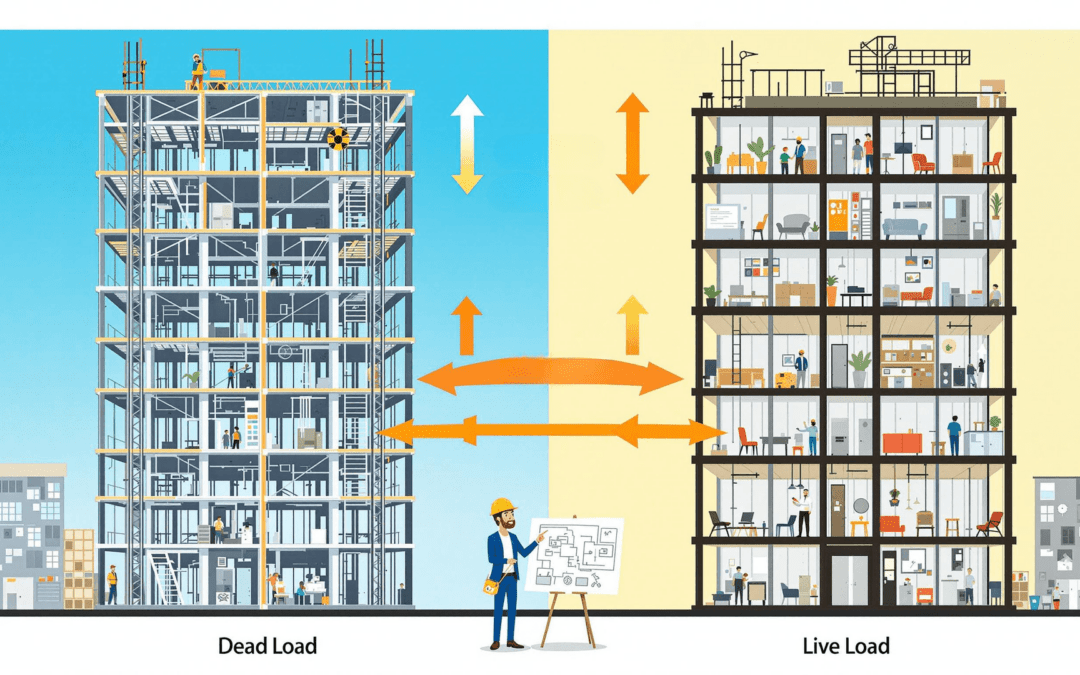Loads on Structures Explained: Dead Load vs. Live Load
Structural engineering is a critical field that ensures the safety and integrity of buildings. Central to this discipline are the concepts of dead loads and live loads, which are essential for anyone looking to hire a structural engineer. Understanding these loads is crucial in designing stable and efficient structures.
What Are Loads in Structural Engineering?
In the context of structural engineering, loads refer to forces or other actions that lead to deformations, stresses, and displacements in a structure. They are essential considerations during the design process to ensure that structures can withstand various forces over time. Loads are generally categorized into two main types: dead loads and live loads.
Understanding Dead Loads
Dead loads are the permanent or static forces acting on a structure. They primarily consist of the weight of the construction materials themselves. The importance of dead loads lies in their constancy, as they do not change over time, making them predictable for structural analysis.
Components of Dead Loads
- Construction Materials: The weight of floors, walls, roofs, and other structural components.
- Fixed Fixtures: Includes immovable parts such as plumbing, electrical installations, and built-in cabinets.
- Permanent Additions: These might include elements like flooring finishes or permanently installed furniture.
The accurate calculation of dead loads is vital because it directly influences the structural integrity and design efficiency. When you hire a structural engineer, ensuring they provide precise dead load calculations can help optimize material use and overall cost.
Understanding Live Loads
Unlike dead loads, live loads are transient and variable forces acting on a structure. They account for the movable items within a building and any temporary forces it may encounter.
Components of Live Loads
- Occupant Weight: The weight of people and animals using the space.
- Furniture and Equipment: Movable items like desks, chairs, machinery, or any non-permanent fixture.
- Environmental Factors: Includes snow, wind, and seismic activities, which can affect a building at various times.
Importance of Live Loads
The unpredictable nature of live loads requires careful consideration to ensure safety under varying conditions. By hiring a structural engineer, you benefit from expert evaluations of potential live loads, ensuring that your structure can accommodate these changes without compromising safety.
Differences Between Dead Load and Live Load
- Permanency: Dead loads are constant, whereas live loads vary over time.
- Calculation: Dead loads are easier to calculate due to their constancy, while live loads require estimations and may need adjustments based on usage.
- Impact on Design: Both loads impact material selection and structural design, but live loads demand more flexibility to accommodate changes.
Why Accurate Load Calculations Matter
Accurate load calculations are crucial for a structure’s longevity, safety, and efficiency. A professional structural engineer can provide these calculations, offering a blueprint that enhances the building’s response to both expected and unexpected forces. Ensuring precise load assessments can prevent structural failures and reduce repair and maintenance costs over time.
How to Choose a Structural Engineer
When deciding to hire a structural engineer, consider the following factors to ensure they can efficiently handle load calculations:
- Experience and Expertise: Ensure they have a proven track record with similar projects.
- Credentials and Licensing: Verify their qualifications and professional licensing.
- Communication Skills: Effective communication is essential to ensure your needs are met and understood.
- References and Reviews: Look for reviews or ask for references to gauge their competence and reliability.
Conclusion
Understanding the difference between dead loads and live loads is fundamental for the safe and efficient design of any structure. As you consider your next building project, hiring a knowledgeable structural engineer who can accurately assess these loads is essential. Their expertise will ensure your structure stands the test of time, while safeguarding the people and assets it supports.
Q1: What are loads in structural engineering? A1: In structural engineering, loads are forces or actions causing stress and displacement in structures. They are crucial for designing stable buildings and come in two main types: dead loads, which are static, and live loads, which are variable.
Q2: What is a dead load? A2: A dead load refers to permanent forces acting on a structure, mainly due to construction materials like beams, walls, and roofs. Since they are constant, they are predictable and crucial for the structural design.
Q3: What is a live load? A3: A live load consists of variable forces on a structure, such as occupants, furniture, and environmental factors like snow and wind. These loads are crucial for design and require careful consideration due to their unpredictable nature.
Q4: How do dead loads and live loads differ? A4: Dead loads are static and constant, whereas live loads are dynamic and change over time. Both affect material selection and design, but live loads demand more flexibility in design to accommodate changes.
Q5: Why are accurate load calculations important? A5: Accurate load calculations are vital for a building’s safety and longevity. They ensure structures withstand forces without failure. Hiring a structural engineer ensures precise load assessments, reducing potential risks and costs.
Q6: How can one hire the right structural engineer? A6: To hire a structural engineer, check for experience, credentials, communication skills, and references. A qualified engineer ensures that your building’s load calculations are precise and reliable.

